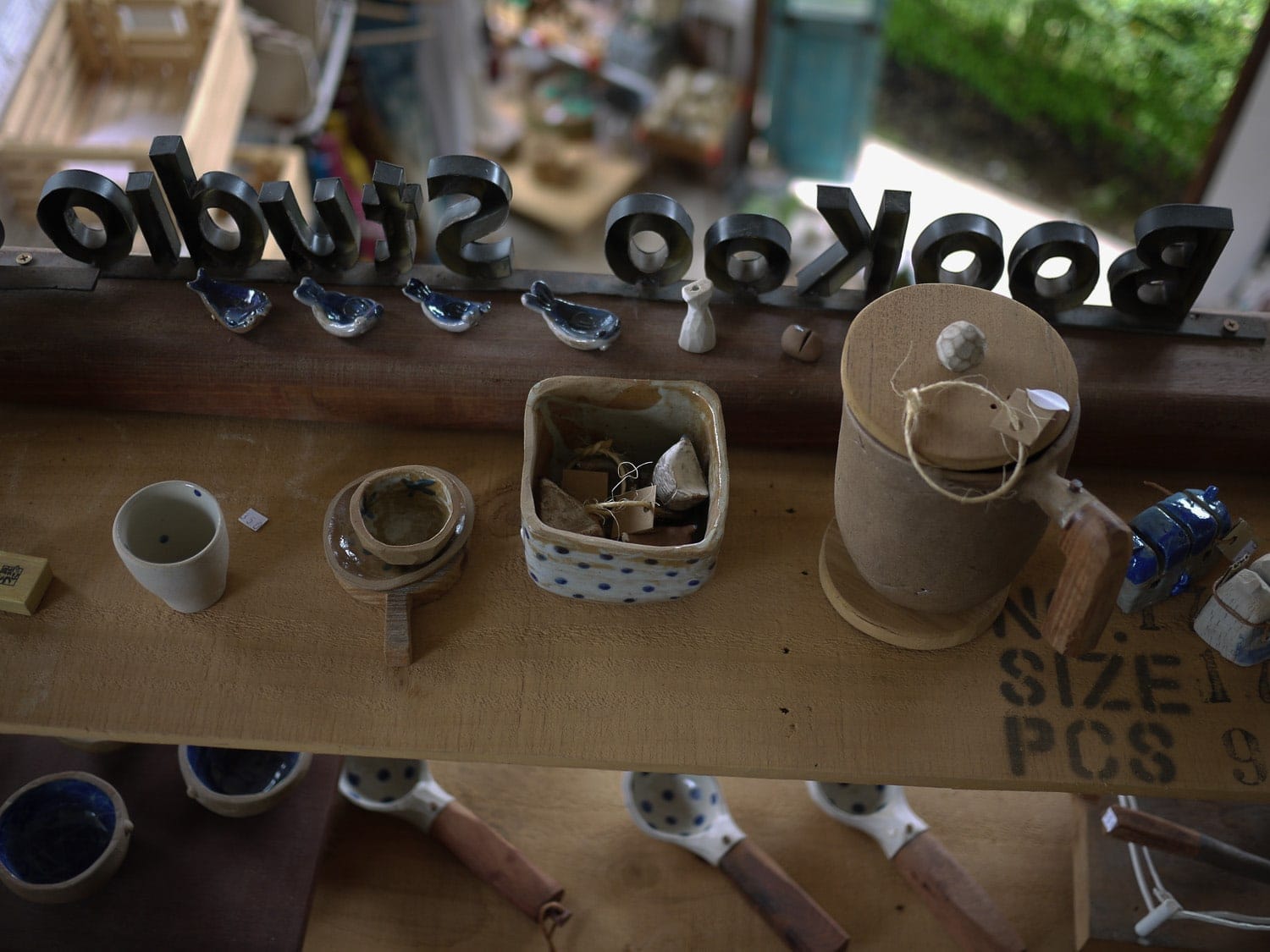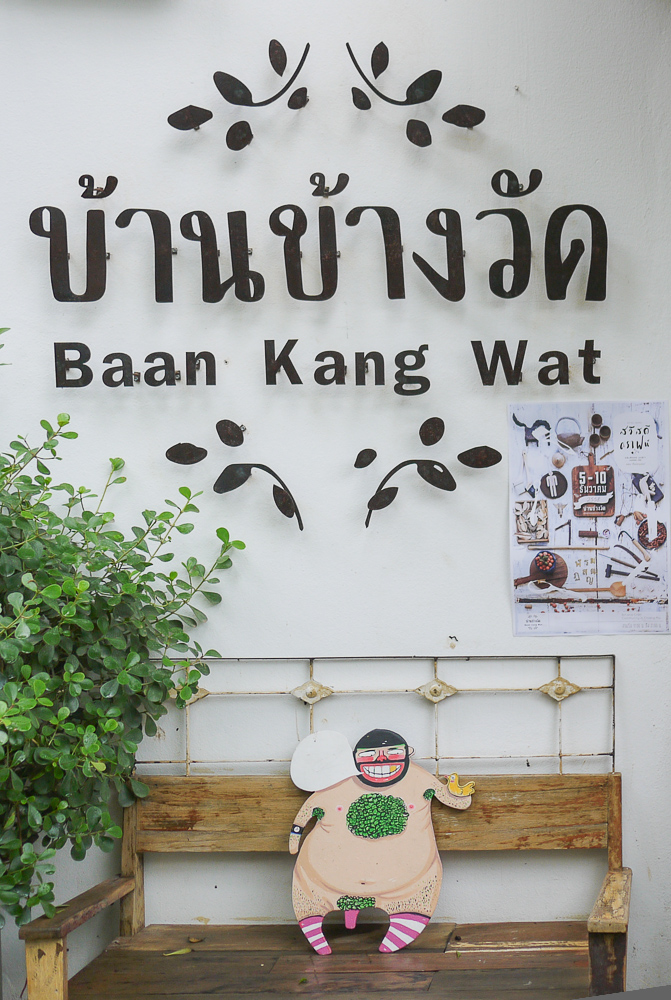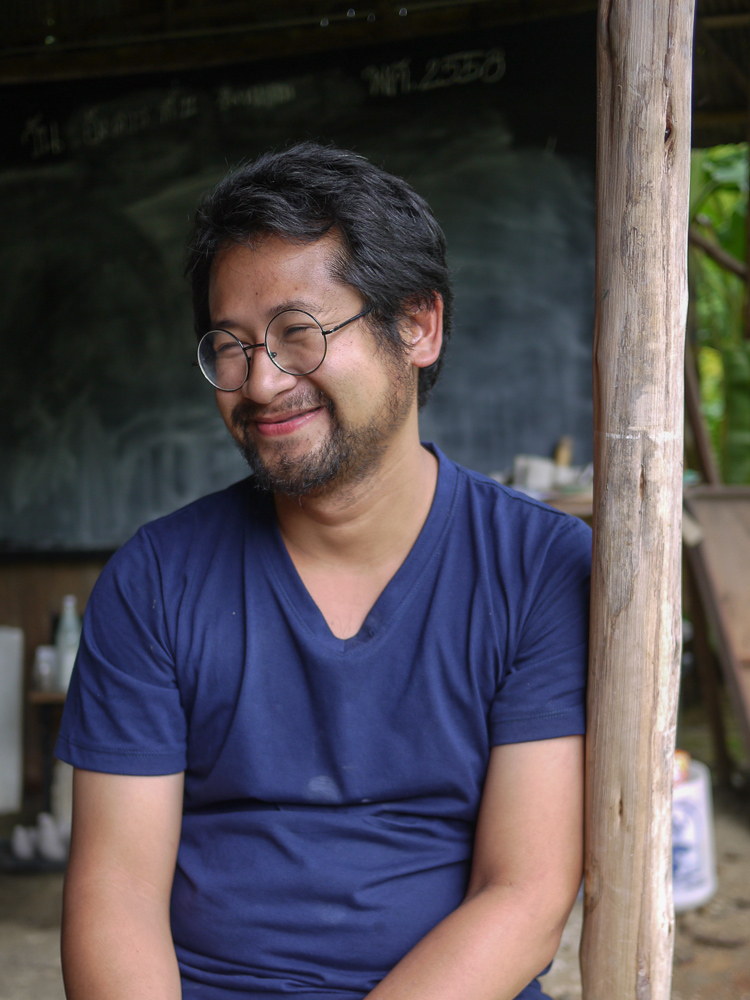 Best known for his small-scale, finely worked objects made from clay and wood, Nattawut Ruckprasit didn’t earn his Thai nickname ‘Big’ based on the nature of his sculptural ceramics. Earthen-hued, tactile and imperfect, the tiny objects he crafts under the name BooKoo Studio are scarcely larger than the size of your hand. By contrast, the life-sized Baan Kang Wat artist community is his largest and most ambitious creative project to date.
Best known for his small-scale, finely worked objects made from clay and wood, Nattawut Ruckprasit didn’t earn his Thai nickname ‘Big’ based on the nature of his sculptural ceramics. Earthen-hued, tactile and imperfect, the tiny objects he crafts under the name BooKoo Studio are scarcely larger than the size of your hand. By contrast, the life-sized Baan Kang Wat artist community is his largest and most ambitious creative project to date.
Hewn from jungle thicket in the foothills of Chiang Mai’s Doi Suthep, Baan Kang Wat is a living, breathing artist’s village designed and built around Big’s philosophy for creative codependence and shared wealth. This thriving community provides permanent retail spaces for 13 craftspeople and cafe owners in a laid-back atmosphere. The community also hosts a range of events and workshops throughout the year.
Emily Lush and Lauren K. Lancy of The Kindcraft visited Baan Kang Wat to chat with Big about his work and the upcoming ‘Sawadee Craft’ festival, which takes place at Baan Kang Wat between December 5 – 10, 2015.
AN ARTIST’S VILLAGE IN CHIANG MAI
Stepping stones turn to concrete lanes turn to dirt tracks as a long pathway winds itself through Baan Kang Wat. Moving around the artist’s village on a rainy Sunday afternoon, teak-framed vignettes of 13 different lives appear at 13 doorways, many of which are flung open to permit the remains of a post-monsoon breeze. After choosing between the handful of first-floor cafes and ordering a coffee, it’s not long before we get our first glimpse of Nattawut Ruckprasit, better known as ‘Big’ who is tracing the same journey between buildings, weaving in and out of doorways to chat with tenants and visitors as he goes. Then with a salutary wave, he disappears into BooKoo Studio and recommences the sanding, painting, and glazing that usually consumes the better part of his day.
A ceramicist and sculptor by trade, Big has been working with clay for the better part of two decades. Just like the petite, finely detailed utilitarian and decorative objects he creates under BooKoo Studio, Baan Kang Wat is a handcrafted product of the artist’s imagination, albeit realised on a much grander scale. Inspired by the culture of the Akha people, an ethnic minority who reside in the hills of Northern Thailand, the village aims to evoke memories of a simpler time when the wat (Buddhist temple) was the centrepiece of daily life and Thai villages (called baans) took the name of the closest temple. Having grown up in one of the country’s central provinces before relocating to Thailand’s second biggest city, this was the kind of life Big once knew. Baan Kang Wat, he explains, is an attempt to recreate this idyllic atmosphere on the city’s fringe, serving as an ideal trading space for members of Chiang Mai’s independent community of creatives, and a unique visitor’s attraction for locals and tourists alike.
The initial concept for Baan Kang Wat dates back to 2009. It took several years for Big to secure funding for the project from local investors, and ground was broken in 2012. The plot of land where the village now stands, Big explains, was chosen for its proximity to both a temple and one of Chiang Mai’s most popular student neighbourhoods. Erected where thick forest once stood, the landscape in and around the site remains verdant and overgrown, creating the impression that the jungle has grown up around the village.
[SlideDeck2 id=2803]
Baan Kang Wat consists of 13 multipurpose buildings crafted from teakwood and brushed concrete and gathered together in a tightly knit cluster. Each individual structure, which Big refers to as a house, was designed by the artist himself and drawn up with the help of an architect. Modeled on a traditional Northern Thai dwelling – some with an added third story – every house contains a twisted mix of indoor and outdoor spaces that cater to a range of activities: making, exhibiting, selling, learning, entertaining, and everyday living.
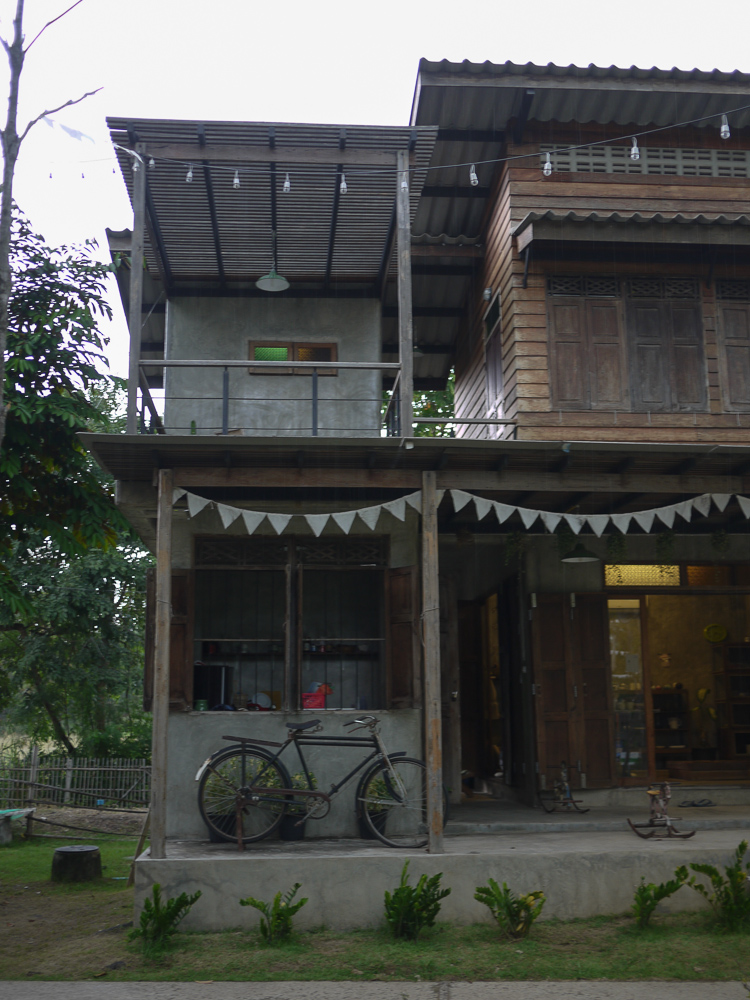 Ten of these 13 self-contained houses have the adequate space and amenities to serve as a permanent family residence. Windows and doorways have been placed to maximize ventilation, natural light and insulation, adding up to what Big describes as “good living” for the baan’s inhabitants. The site’s landscaping, also masterminded by the artist, has a spectacular grass-lined sunken amphitheater at its heart near the entrance. A rambling productive garden is at the back of Baan Kang Wat, where Big has his studio.
Ten of these 13 self-contained houses have the adequate space and amenities to serve as a permanent family residence. Windows and doorways have been placed to maximize ventilation, natural light and insulation, adding up to what Big describes as “good living” for the baan’s inhabitants. The site’s landscaping, also masterminded by the artist, has a spectacular grass-lined sunken amphitheater at its heart near the entrance. A rambling productive garden is at the back of Baan Kang Wat, where Big has his studio.
Each retail, food, and service provider that the baan accommodates has been carefully selected based on its owner’s commitment to Big’s philosophy. Businesses span handicraft stores, family owned restaurants and coffee houses, and an old-fashioned barbershop is the village’s most recent addition. The key objective of Baan Kang Wat, Big confirms, is to provide a low rent option for these shopkeepers, many of whom are independent craftspeople and unable to meet the rising costs of rent in Chiang Mai city. “Sharing is good for business,” Big adds, explaining how once a new business moves in, common economy takes over, promising shared benefits for all tenants.
Individual shops observe the Baan’s regular opening hours and as well as living on site, many makers and creatives tend their own stores. Eliminating the need for middlemen staff not only helps to maximize profits, but also creates the imperative for craftspeople to connect with their customers personally and in real time. More than just a commercial space, the baan has grown to represent an experiment in collective living. Those shop owners who sleep above their stores also eat meals together, forming friendships that fortify the baan’s community feel.
BOOKOO STUDIO
You need only look to Big’s own artistic practice to trace the aesthetic beginnings of Baan Kang Wat. On reflection, the village’s teak and concrete houses can be interpreted as life-size incarnations of Big’s palm-sized ceramics, each a deliberate balance of hand-painted clay and wood. Resolving these two contrasting materials has been something of an obsession for Big, who chose to research mixed media as the topic of his thesis 15 years ago when he was a Fine Arts student at Chiang Mai University.
[SlideDeck2 id=2860]
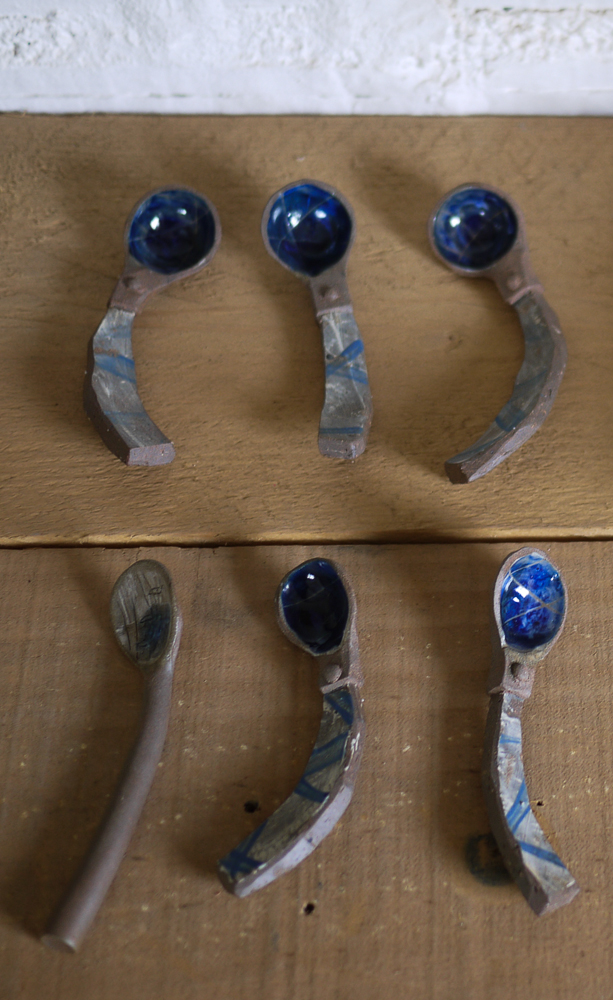 Now 35, his practice has been devoted to ceramics and small objects for over a decade. Most of his work takes place in a sprawling, open-air ceramics studio, while his woodwork is done offsite in a neighborhood in eastern Chiang Mai called Nong Hoi. Baan Kang Wat is also home to the BooKoo Studio shopfront, a lofted retail space that showcases that artist’s most recent works.
Now 35, his practice has been devoted to ceramics and small objects for over a decade. Most of his work takes place in a sprawling, open-air ceramics studio, while his woodwork is done offsite in a neighborhood in eastern Chiang Mai called Nong Hoi. Baan Kang Wat is also home to the BooKoo Studio shopfront, a lofted retail space that showcases that artist’s most recent works.
“Every material has a sprit and must be respected,” Big says of the unfinished clay, glazing samples and wooden artifacts that litter his workbench, again eluding to the ideals of Akha hill tribe culture that permeate his practice. With nature as his ultimate source of inspiration, many of the vessels and small objects that Big makes conform to organic, imperfect shapes. He also notes the tenants of zakka, a Japanese concept denoting the ‘many things’ that can improve your lifestyle and surroundings, as one of his muses. “Simple if perfect,” Big emphasizes.
SAWADEE CRAFT
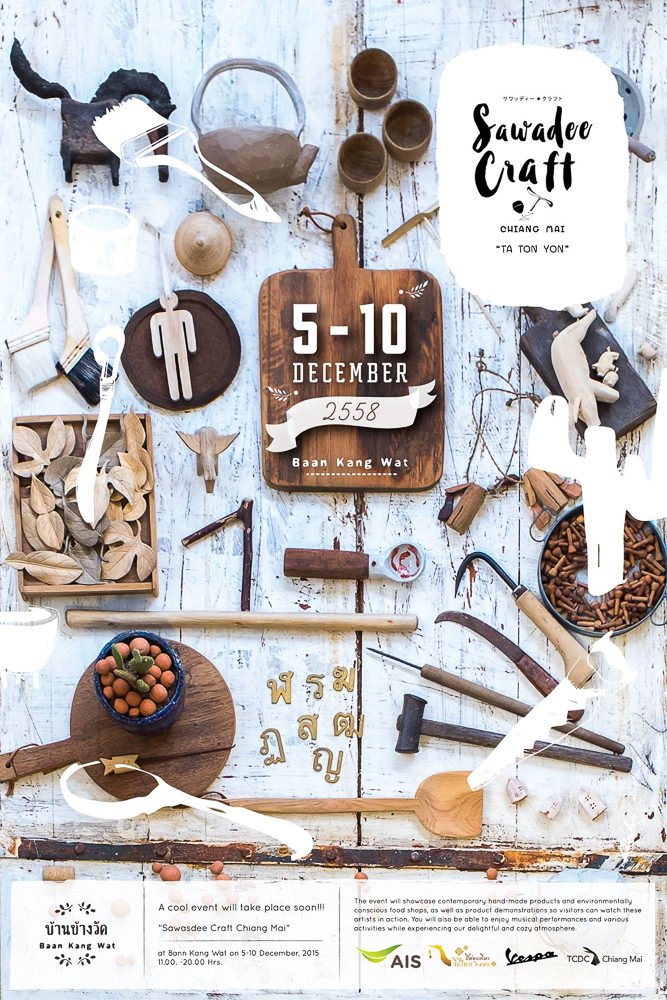 A blackboard crowded with intricate Thai script spans the entire length of Big’s garden studio and along the top the words ‘Sawadee Craft‘ are written in English, a clue as to the topic of his recent meetings and newest creative venture. The name Sawadee Craft is a clever take on “Sawadee Krub” which is a potite greeting used by Thai men, while women use “Sawadee ka” to say “Hello”.
A blackboard crowded with intricate Thai script spans the entire length of Big’s garden studio and along the top the words ‘Sawadee Craft‘ are written in English, a clue as to the topic of his recent meetings and newest creative venture. The name Sawadee Craft is a clever take on “Sawadee Krub” which is a potite greeting used by Thai men, while women use “Sawadee ka” to say “Hello”.
Baan Kang Wat regularly hosts workshops in ceramics, dyeing, stamping, crocheting and cooking throughout the year, and occasionally stages larger events including an annual film festival. From December 5 – 10 2015, the village will be the setting for Sawadee Craft, a new makers festival designed to connect artisans with buyers through direct trade. Co-promoted by the Thailand Creative & Design Center (TCDC) and featuring gallery exhibits, live music and an artist showcase, it’s Big’s hope that Sawadee Craft will help foster new connections and promote his Baan’s philosophy.


